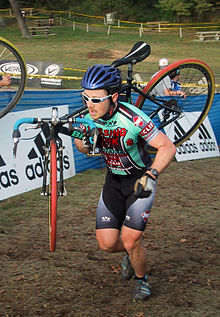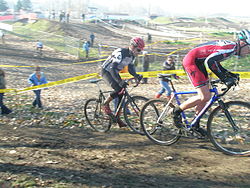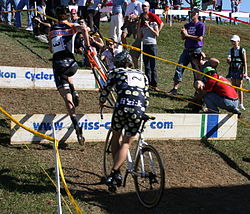- Cyclo-cross
-
Cyclo-cross (sometimes cyclocross, CX, CCX, cyclo-X or 'cross') is a form of bicycle racing. Races typically take place in the autumn and winter (the international or "World Cup" season is September–January), and consists of many laps of a short (2.5–3.5 km or 1.5–2 mile) course featuring pavement, wooded trails, grass, steep hills and obstacles requiring the rider to quickly dismount, carry the bike whilst navigating the obstruction and remount.[1][2] Races for senior categories are generally between 30 minutes and an hour long, with the distance varying depending on the ground conditions. The sport is strongest in the traditional road cycling countries such as Belgium (and Flanders in particular), France and the Netherlands.
Cyclo-cross has some obvious parallels with mountain bike racing, cross-country cycling and criterium racing. Many of the best cyclo-cross riders cross train in other cycling disciplines. However, cyclo-cross has reached such a size and popularity that some racers are specialists, and many never race anything but cyclo-cross races[citation needed]. Cyclo-cross bicycles are similar to racing bicycles: lightweight, with narrow tires and drop handlebars. However, they also share characteristics with mountain bicycles in that they utilize knobby tread tires for traction, and cantilever style brakes for clearance needed due to muddy conditions. They have to be lightweight because competitors need to carry their bicycle to overcome barriers or slopes too steep to climb in the saddle. The sight of competitors struggling up a muddy slope with bicycles on their shoulders is the classic image of the sport, although unridable sections are generally a very small fraction of the race distance.
Compared with other forms of cycle racing, tactics are fairly straightforward, and the emphasis is on the rider's aerobic endurance and bike-handling skills. Drafting, where cyclists form a line with the lead cyclist pedaling harder while reducing the wind resistance for other riders, is of much less importance than in road racing where average speeds are much higher than in cyclo-cross.
A cyclo-cross rider is allowed to change bicycles and receive mechanical assistance during a race. While the rider is on the course gumming up one bicycle with mud, his or her pit crew can work quickly to clean, repair and oil the spares. Having a mechanic in the "pits" is more common for professional cyclo-cross racers. The average cyclo-cross racer might have a family member or friend holding their spare bike.
Contents
Origins and history
There are many stories about the origins of cyclo-cross. One is that European road racers in the early 1900s would race each other to the next town over from them and that they were allowed to cut through farmer's fields, over fences or take any other shortcuts in order to make it to the next town first. This was sometimes called steeple chase as the only visible landmark in the next town was often the steeple. This was a way for them to stay in shape during the winter months and put a twist on road racing. In addition, riding off road in more difficult conditions than smooth pavement increased the intensity at which the cyclists were riding and improved their on-the-road bike handling abilities. Forced running sections, or portage, were incorporated to help deliver warm blood to the feet and toes, as well as exercise other groups of muscles. Daniel Gousseau of France is credited as having inspired the first cyclo-cross races and organizing the first French National Championship in 1902.[3] Géo Lefèvre, the originator of the idea for the Tour de France, also played a key role in the early days of the sport.[4]
After Octave Lapize attributed his win in the 1910 Tour de France to his off season training in cyclo-cross[5] the sport began to spread to countries bordering France. Belgium organized its first National Championship in 1910, Switzerland did so in 1912, then Luxembourg in 1923, Spain in 1929 and Italy in 1930.
Cyclo-cross proved itself as a sport extending beyond the boundaries of France when in 1924 the first international race, Le Critérium International de Cross-Country Cyclo-Pédestre, was held in Paris.[5]
Like many international cycle sports, CX is administered by the Union Cycliste Internationale; although it wasn't until the 1940s, around 40 years after cyclo-cross' inception, that the UCI began its regulation and the first world championship was held in Paris in 1950.[5]
Cyclo-cross began to become popular in the US in the 1970s and in 1975 the first race was held in New England but the first US National Championship was held in Berkeley, CA. The Surf City race series held in Santa Cruz, CA holds a lot of history of cyclo-cross in the US. The sport has experienced a growth in popularity in the US since the mid 90s[6] and now the Pacific Northwest hosts some of the largest events in the country.[citation needed]
Racing seasons
Cyclocross is typically an Autumn and Winter sport, the northern hemisphere season running from September to February. The World Championships take place in late January. The Canada and US national championships are held in November and December, with little racing after that except in the climates of the Southern and Western United States like California.
Riders' age categories for cyclocross under UCI rules are currently determined by their age on 1 January which lies in the middle of the international season, i.e. they compete in the same category that they would be in for the following road season.
Equipment
Bicycles
Main article: Cyclo-cross bicycleCyclo-cross bicycles roughly resemble road racing bicycles. The major differences between the two are that cyclo-cross frames have wider clearances, knobby tires, cantilever brakes, and lower gears. A rear brake cable routed on the upper right side of the top tube allows the rider to carry the bike on the right shoulder through portage sections. Popular on many cyclocross bikes is routing the brakes opposite that of a classic road bike, meaning the right brake is often the front brake. This is done because a majority of a bicycle's stopping power comes from the front brake, and many people use the right brake more often than the left brake. As a high-end bicycle purpose-built for a specific sport competition, they also differ from ordinary cross bikes, which are general-purpose utility bikes fitted with slightly wider 700C tires for use on unpaved paths or trails.[7]
Cyclo-cross bike design and frame geometry has varied over the years. For example, a heightened bottom bracket was typical 10+ years ago; now many cyclo-cross-specific frames do not have elevated bottom brackets. Many cyclo-cross bicycles are set up with a single chainring and chain "drop" guards. A single chainring allows for a tighter chainline, thus reducing the chance of the chain coming off on a bumpy course. People that do run a double chain-ring set up on their bicycles generally use a 38-46 gearing. In addition, single speed bicycles are becoming increasingly popular for a variety of reasons including lower Initial cost and setup, ease of use and maintenance, and decreased likelihood of mechanical failure on the course.
Clothing
Clothing is similar to that of road racing. However, since cyclo-cross is a cold-weather sport there is an emphasis toward warmer clothing such as long sleeves, tights, knickers and arm and leg warmers. In the warmer races there is a very strong preference for skinsuits for maximizing freedom of movement. The other advantage of skinsuits is that they are tighter, preventing the jersey from getting caught on stray tree branches during some singletrack sections of the race course. The one piece construction of the skinsuit also prevents it from exposing the torso while the rider shoulders the bike. Mountain bike shoes are adopted, as they allow the competitors to run, unlike their road racing counterparts and their degree of traction (compared to smooth bottoms found on road racing shoes). Toe studs are used to aid in running up steep muddy slopes and in the adverse underfoot conditions.
Courses
Races almost universally consist of many laps over a short course, ending when a time limit is reached rather than after a specific number of laps or certain distance; the canonical length for senior events is one hour. Generally each lap is around 2.5-3.5 km and is 90% rideable. Races run under UCI rules must have courses that are always at least 3 m wide to encourage passing at any opportunity, however sections of singletrack are common for small races in the USA and Great Britain. A variety of terrain is typical, ranging from roads to paths with short steep climbs, off camber sections, lots of corners and, a defining feature, sections where the rider may need, or would be best advised to dismount and run whilst carrying the bike. Under-tire conditions include asphalt, hardpack dirt, grass, mud and sand. In comparison to cross-country mountain bike events, terrain is smoother. Less emphasis is put on negotiating rough or even rocky ground with more stress on increased speed and negotiating different types of technical challenges.
Each section of the course typically lasts no longer than a handful of seconds. For example long climbs are avoided in favour of short, sharp inclines. Sections are generally linked together, or long straights broken up, with tight corners. This not only allows a standard length course to fit in a relatively small area, but also forces competitors to constantly change speed and effort. Accelerating out of corners, then having to decelerate for the next before accelerating again is a common theme.
Obstacles that force a rider to dismount and run with their bike or to "bunny hop" include banks too steep to ride up, steps, sand pits and plank barriers. Besides the start/finish area, these obstacles may be placed anywhere on the course that the race director desires. Several race directors have tried to limit bunny hopping by placing barriers in pairs or in triple (although under UCI rule no more than two barriers can appear in succession), however this hasn't stopped some of the best bunny-hoppers from getting over them. The regulation height for a barrier is 40 cm although this is treated as a maximum at smaller events. Plank barriers seem to be more common in the US than in Europe and UCI regulations only permit one section of them on the course.
Since outside assistance is allowed, pits are included to provide a consistent area for this to occur. A pit to the right of the course is normal since most riders dismount to their left. In larger events a separate pit lane is featured so only those wishing a new bike or other assistance need enter the lane (this type was debuted at the Zeddam, Netherlands World Cup of January 1999). In some cases pits are provided in two different parts of the course.
Long-format races, in which riders compete cross country for distances up to 100km, are becoming more common. The longest-running event is {[1] Three Peaks Cyclo-Cross], a 61 km single lap race held annually in Yorkshire, England. [2] The American UltraCross Championship Series] consists of four races ranging from 75 to 100km.
Technique
Although courses are less technical than those of mountain biking, the particular obstacles require specific technical abilities of their competitors. However, single-track and streams (like in mountain biking) are also sometimes part of the course, depending on the location, both of which require rider experience and technique. More common, however, are steps, barriers, ditches, stairs, steep slopes and deep mud or sand which require running while carrying the bicycle. This approach was invented by Octave Lapize and proven by Eugène Christophe who in 1913 had to carry his broken bike down the Tourmalet during the Tour de France[original research?]. Although this sounds simple, doing so in the middle of a quick-paced race is difficult. Being able to dismount, pick up the bike, put it back down and remount smoothly and quickly requires practice and skill.[clarification needed].
A more recent development to overcome obstacles such as barriers and sometimes ditches is the bunnyhop, which came to prominence in 1989 when Danny De Bie used it in his successful World Championship run. Bunny hopping has become less popular as a result of race directors seeking to limit its use by setting up two or three barriers in a row. Skilled riders are still able to hop the obstacles, despite the back to back to back barriers. Today[when?] Sven Nys, an ex-BMX racer, demonstrates the importance of technical skills as he continues to dominate the sport.
Cyclo-Cross Series' and Major Races
- The Cross Crusade (USA)
- Seattle Cyclocross Series (SCX) (USA)
- UCI Cyclo-cross World Championships
- UCI Cyclo-cross World Cup
- Superprestige (Cyclo-cross) (Europe)
- GvA Trophy (Belgium)
- National Cyclo-cross Championships
- U.S. Gran Prix of Cyclocross (USA)
- Georgia 'Cross (USA)
- National Trophy Series (UK)
- Sportif 'Cross Cup (USA)
References
- ^ uci.ch UCI Cyclo-cross regulations
- ^ usacycling.org USA Cycling Federation rulebook
- ^ Cyclocross: History & What You Should Know Konrad, Gabe: "Cyclocross: History & What You Should Know". Bicycle Trader Magazine, 1996. Retrieved August 19, 2005.
- ^ cyclingnews.com, "Who got their tyres crossed?", 9 November 2006
- ^ a b c books.google.com Herlihy, David V. "Bicycle: The History", page 397. Yale University Press, 2004.
- ^ books.google.com Burke, Edmund R. & Pavelka, Ed: "The Complete Book of Long Distance Cycling", Page 254. Rodale, 2000.
- ^ Ballantine, Richard, Richard's 21st Century Bicycle Book, New York: Overlook Press (2001), ISBN 1585671126, pp. 34, 307
- "Cyclo-cross Organiser's Workbook". British Cycling. Retrieved September 29, 2006.
External links
- Cyclocross Magazine is a print magazine, website and online community dedicated cyclocross news, race coverage, products, and culture.
- The Cyclocross News - Coverage from the top blogs, pro racers and news sources.
- UK Cyclocross - A social network dedicated to cyclocross in the United Kingdom.
- Cyclo-cross Videos - Helmet camera videos of Cyclo-cross racing
- British Cycling Cyclo-X pages - Lots of information on the UK Cyclo-X scene
- Plus One Lap cyclo-cross info/FAQ/ - Cyclocross Bike Gallery of lightweight and custom bikes.
- Cyclofiend.com CX Bike Gallery - Gallery of Cyclocross Bicycles
- Video highlights of the latest European races
- Notts & Derby Cyclo-cross League - UK regional cyclo-cross league for Nottinghamshire and Derbyshire
- North Western Cyclo-cross Association - The UK's regional cyclo-cross league for the North West region
- CyclingReporter.com Cross articles and how-tos for beginning and experienced racers
- Muddy Hell Major night-time Cross event in London, UK.
Bicycle racing Road bicycle racing · Cyclo-cross · Mountain bike racing · Track cycling · BMX racing · Cycle speedwayCategories:
Wikimedia Foundation. 2010.



